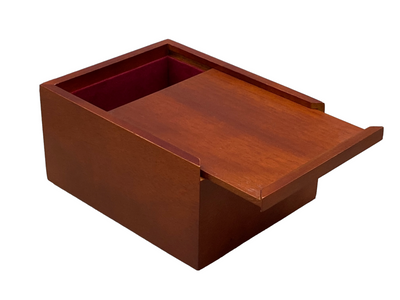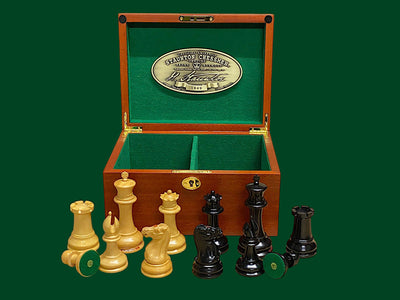How to Look after your Chess Sets
The Chess Company, we make sure that our chess boards, chess pieces, and backgammon boards arrive at your doorstep beautifully finished and ready to use. However, these boards and pieces do require a little care to keep them looking their best. Some of our products require more care than others and each has its own special care instructions. Below is an outline of how to best care for your chess sets or backgammon set.
CHESS PIECES
Chess pieces: polished wooden
Most of our wooden chess pieces are finished with a thin layer of shellac, applied by hand. This gets into the wood and creates a protective layer to keep out dirt as well as oils from your fingers as you handle and use the pieces. This process keeps the wood looking and feeling natural, but helps it to keep its new look longer. It's not difficult to take care of your naturally-polished chess pieces. You simply rub the pieces with a dry, lint-free cloth. You don't have to add any extra waxes or polishing agents. The original shellac is durable and doesn't rub off easily. If the pieces get something on them, just wipe them carefully with a damp, soft cloth and use a second dry cloth to remove the excess moisture. 
Chess pieces: Lacquered
Lacquered wooden chess pieces are coated with a thin layer of lacquer-like nitrocellulose or nitrocellulose. This type of chess piece is very hardy and needs very little care to keep it looking its best. To clean such pieces, all you need is to rub them with a dry, lint-free cloth. If the pieces should get a little sticky or get something on them, use a damp cloth with just a little dish detergent. Be careful as you polish your lacquered chess pieces, as lacquer scratches very easily. If you DO get scratches, you can minimize the damage by buffing the piece with a little good-quality automobile buffing agent. Strong compounds and ammonia-based rubbing compounds should be avoided since they are too abrasive and may discolor or crack the lacquer.
Chess pieces: metal
Chess pieces made of metal are made with a very thin coating of clear lacquer on the outside to help prevent tarnishing and staining that can occur from the natural oils from one's hands. For these pieces, you just need a dry, lint-free cloth to keep them clean. Simply rub them lightly with the cloth. If a piece gets sticky, use a damp cloth with a little dish detergent, followed by a dry cloth to remove the excess moisture.
For metal pieces without a lacquer coating--usually those made from metals that don't tarnish easily--just wipe them with a dry cloth. As with the lacquered metal pieces, use a damp cloth followed by a dry cloth to clean any sticky pieces.
Chess pieces: plastic
Plastic chess pieces are the easiest pieces of all to care for. If they get sticky or dirty, simply wipe them with a damp cloth with a little dish detergent and allow to air dry.
stone and poly/resin
Synthetic or semi-synthetic molded chess also require very little care to keep them looking beautiful. These pieces do not require polishing. In fact, polishing can actually damage this type of chess piece. To clean these pieces, simply dust with a dry, lint-free cloth and use a damp cloth with a little dish detergent on it to remove any stickiness or foreign substances.
CHESS BOARDS
Chess boards: solid wood with a lacquered finish
Wooden chess boards are most commonly finished with a relatively thick coating of lacquer-like nitrocellulose or melamine. Some older wooden chess boards may be coated with an oil-based lacquer, but newer boards are generally made using an acrylic-based lacquer. The method of care is the same for both types of boards. Simply dust the board with a dry, lint-free cloth and use a damp cloth with a little dish detergent followed by a dry cloth if the board is sticky. Either way, the process of after-care is the same. Lacquered chess boards can lose their sheen over time or even get a few scratches. To minimize this damage, use a very small dab of automotive buffing cream and work it into the board, one area at a time. Be careful not to apply too much pressure. After the compound has been applied, rub it out gently with a dry, lint-free cloth. Avoid using ammonia-based compounds as these are abrasive and can scratch the board further. 
solid wood matte or satin lacquer
It's very easy to keep solid wood satin and matte-lacquered chess boards looking their best. Simply dust regularly with a clean, soft cloth. Remove any stickiness or other matter with a damp cloth using a dab of dish detergent, then get rid of any excess moisture with a clean, dry cloth. Avoid polishing or removing scratches with a buffing compound on these boards as the act of rubbing the scratches out will turn your satin finish into a gloss finish.
Solid polished wood
Chess boards made of solid, polished wood are generally finished using a wax product. Animal-based waxes, such as beeswax, are the most commonly used. Such waxes permeate the wood and offer a reasonable degree of protection against dust and dirt for a limited time. To keep the board looking its best, the wax needs to be re-applied every so often. We recommend that you re-wax your polished wood chess board every six months or so. Avoid using turpentine-based waxes as they can actually harm the board (not to mention the environment.)
The waxing process is relatively easy. Begin by applying a small dab of wax to a clean, lint-free cloth and rubbing the wax lightly into the wood using a circular motion. After the entire board has been waxed, allow it to dry from ten to 15 minutes. Once the board is dry, buff out any excess wax and polish the board to a fine sheen. Daily or weekly dusting will keep the board looking good for another six months.
Veneer Wood Gloss Lacquered
Veneer wood chess boards finished with a lacquered gloss can be maintained in a similar fashion to solid wood chess boards with a glossy, lacquered finish. Be aware that most veneer boards have a thinner coating of lacquer than solid wood lacquered boards. Because of this, you should exercise care when polishing out scratches or other imperfections.
veneer wood satin lacquered
Maintain your matte lacquered veneer board the same way you'd take care of as a matte varnished solid wood board. That means simply wiping the board with a dry, clean cloth and using a damp cloth with a little dish detergent to get rid of any stickiness. Avoid polishing or rubbing your board to remove scratches as they can turn your matte finished board into a glossy board.
Veneer Wood Polished
Veneer wooden chess boards with a naturally-polished finish can be maintained the same way as solid wood polished boards. (Wax with beeswax every six months or so and for daily or weekly maintenance, just wipe the board with a dry, clean cloth and/or use a damp cloth with a little dish detergent to remove any foreign substances or stickiness.) Be aware that veneers are much thinner than solid wood and take much less was to keep them looking shiny and new.
Folding Chess Sets gloss Lacquered
Folding chess sets with a high sheen lacquer finish are very sturdy and do not need much regular care. Just wiping the set with a clean, dry cloth periodically should keep your set looking like new for years to come. If the set gets sticky, add a little dish detergent to a damp rag and wipe the pieces. Follow up with a dry cloth to remove any excess moisture. Remove any small scratches by using a mild automotive buffing compound.
Polished wooden
Wooden folding chess sets with a naturally-polished finish are usually coated with a light layer of Beeswax. This coating protected against dirt and dust but needs to be reapplied every six months or so. To do this, use a natural beeswax product and rub the was into the board using the wax sparingly. After the wax has dried, buff the board to a polished sheen. For everyday maintenance, dust with a clean, dry cloth.
Backgammon Sets
The majority of wooden backgammon sets are either finished with a light coating of lacquer or are naturally polished. To keep these sets clean, wipe the cabinet with a soft, dry cloth. Use a damp cloth with a dab of dish detergent to remove any stickiness or foreign substance. Remove any excess moisture with a second, dry cloth. Do you use any waxes or polishes?
Backgammon sets: leather Backgammon sets made of leather require a little more than just a wipe with a clean dry soft cloth. To keep these sets looking their best, we advise cleaning them once a year with a good leather conditioner.
Backgammon sets: leatherette Leatherette backgammon are easy to keep clean. You only need to wipe down such sets need with a damp, soft cloth.








